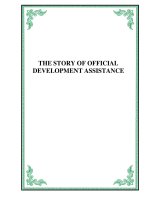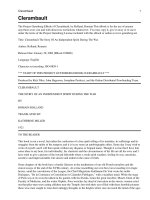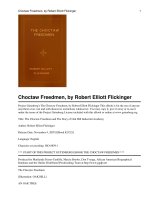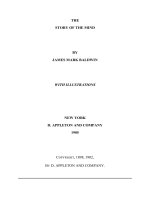- Trang chủ >>
- Mầm non - Tiểu học >>
- Lớp 5
5 3 1 the story of flight TG
Bạn đang xem bản rút gọn của tài liệu. Xem và tải ngay bản đầy đủ của tài liệu tại đây (118.96 KB, 4 trang )
The Story of Flight
SUMMARY
The author offers a brief history of
the development of flight, from the drawings
of Leonardo da Vinci to the use of the
Concorde. She describes many uses of flight,
including mail delivery, passenger service, and
weapons transport.
LESSON VOCABULARY
admiringly
scoundrels
worthless
permit
subject
INTRODUCE THE BOOK
INTRODUCE THE TITLE AND AUTHOR
Discuss with
students the title and the author of The Story
of Flight. Ask students to think about the title
and what the book will be about. Discuss the
concept that, although today we take airplane
flight for granted, at one time people had to
use other methods of transportation.
BUILD BACKGROUND
Discuss with students
what they know about the history of flight and
airplanes. Ask: Have you ever been on an
airplane? How far did you go, and how many
hours did it take?
Invite students to share personal
experiences with flying, using words from their
home languages. Discuss things and people
they might find on an airplane (headphones,
movie, snacks, soft drinks, seat belts,
baggage compartment, flight attendant, pilot,
copilot, etc.).
PREVIEW/USE TEXT FEATURES
Have students
look at the illustration on the title page
and compare it to the photo on page 23.
Discuss differences between the airplanes.
Have students look at the drawing on page
4. Discuss how drawings can help scientists
explain their ideas to others. Ask: What other
purposes might this kind of drawing have?
52
5.3.1
AUTHOR’S PURPOSE
TEXT STRUCTURE
READ THE BOOK
SET PURPOSE
Have students set a purpose
for their reading and keep track of the most
important information related to that purpose.
Suggest that a good way to keep track of
information is to take notes as you read.
STRATEGY SUPPORT: TEXT STRUCTURE
Remind
students that authors use one structure to
organize a book, such as chapter divisions.
They may set up another structure for
explaining the information. Elicit that the
information in this book is organized according
to chronology. Ask students to take notes of
important dates as they read, so they can
follow the development of important events in
the history of flight.
COMPREHENSION QUESTIONS
PAGE 8 What did the Wright brothers do
when they failed in one of their tests or
experiments? (tried to learn something from
their failure)
PAGE 12 What conclusion can you draw about
the effect of World War I on the development
of aviation? (The wish to gain an advantage by
using airplanes in warfare gave a big boost
to aviation.)
PAGE 15 What is the author’s purpose in telling
readers about Amelia Earhart? (The author
wants to inform readers that women pilots
made a contribution to the history of flying.)
PAGE 23
Summarize the major developments
in aviation since the Wright brothers’ 1903
controlled airplane flight. (Responses will
vary but should include Glenn Curtiss’s public
flight; the demand for airplanes to conduct
warfare during World War I; daring flights of
barnstormers; World War II; development of jet
engines; etc.)
The Story of Flight
16917_LRD_TG_052-053 52
1/4/06 9:53:38 AM
REVISIT THE BOOK
READER RESPONSE
1. Possible responses: The author’s purpose is
to inform readers, because of the amount of
factual information presented.
2. Possible responses: 1914–1919, WW I
military planes; 1927, Lindbergh flies across
the Atlantic; 1930s, air travel becomes
popular; 1937, Hindenberg explodes;
airships for passengers discontinued; 1939,
WW II military bombers and fighters; 1958,
first jet travels across the Atlantic; 1970s,
Concorde
3. Possible responses: airplanes, ornithopter,
hot-air balloon, jet, rudders, propellers,
glider, Concorde, wings
4. Answers will vary but should refer to
specific functions and reasons for change.
EXTEND UNDERSTANDING
Suggest that students
look at the illustration and photograph on
pages 22–23. Discuss the concept of the
jumbo jet and what it means for today’s
travelers.
RESPONSE OPTIONS
WRITING
Invite students to write a few
paragraphs imagining themselves as early
pioneers in the history of flight. What kinds
of approaches might they take to creating a
machine that could fly? What would they need
to learn about in order to build this kind of
machine?
WORD WORK Have students review the word
subject in context on page 6. Discuss how
this meaning of subject differs from the way
subject is used in grammar. Repeat this
approach with the other multiple-meaning
word, permit.
Skill Work
TEACH/REVIEW VOCABULARY
After you discuss the meanings of the
vocabulary words, have students brainstorm
to come up with as many synonyms and
then antonyms as they can for each word.
TARGET SKILL AND STRATEGY
AUTHOR’S PURPOSE
Remind students
that when we read for the author’s purpose,
we ask ourselves, “Why did the author write
this book? What was he or she trying to
accomplish?” Suggest that as they read,
they keep in mind whether the author
wants to inform, entertain, persuade, or
express herself.
TEXT STRUCTURE Remind students that
the structure of a book is the pattern that
helps to organize its information. Discuss
how this book has been set up into
chapters. Ask: By reading the chapter titles,
what can you tell about how this book is
organized? What do the chapter titles tell
you about what the author’s purpose
might be?
ADDITIONAL SKILL INSTRUCTION
DRAW CONCLUSIONS
Remind students that
when we draw conclusions, we arrive at
ideas based on what we have read. Suggest
that they examine the illustration on page 7.
Ask: What conclusions can you draw about
the way in which early inventors thought
flight would happen?
SCIENCE CONNECTION
Suggest that students go
to the library to research
inventors in the field of
flight. Can students find elements in their
backgrounds that led them to become
scientific leaders?
The Story of Flight
16917_LRD_TG_052-053 53
53
1/18/06 10:59:27 AM
Name
The Story of Flight
Author’s Purpose
• Author’s purpose refers to the author’s reason for writing.
• The author may want to inform, entertain, persuade, or express himself or herself.
Directions Reread the following excerpt from The Story of Flight. Then answer the questions below.
Jet engines also had a huge effect on air travel. In 1958, the new Boeing 707 carried
passengers nonstop across the Atlantic Ocean from New York City to Paris. This jet airliner
was remarkable for its speed and size. It had room for up to 181 passengers and could travel
600 miles per hour. That year, more than one million people flew between the United States and
Europe. For the first time in history, more people crossed the Atlantic by plane than by ship.
1. Based on these paragraphs, what seems to be the author’s purpose?
2. Which phrase gives you information about the Boeing 707’s size?
3. Which phrase tells you information about the speed of the Boeing 707?
5. What conclusion might you draw about why the author wants to give readers the
information in this paragraph?
© Pearson Education 5
4. Which two sentences give information about the number of people who flew between the
United States and Europe during 1958?
54
16917_LRD_TG_054_055 1
3/20/06 8:56:37 AM
The Story of Flight
Name
Vocabulary
Directions Write a sentence using each of the vocabulary words. Try to make them relate
to airplanes and flight.
Check the Words You Know
admiringly
permit
scoundrels
subject
worthless
1.
2.
3.
4.
© Pearson Education 5
5.
Directions Draw a line from the vocabulary word to its definition.
6. admiringly
to make possible or allow
7. permit
having no value
8. scoundrels
a person who lives under a king’s or queen’s rule
9. subject
with respect and awe
10. worthless
dishonest people
55
16917_LRD_TG_054_055 2
1/4/06 9:54:00 AM









